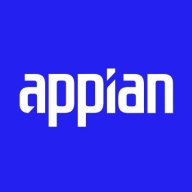

Appian and IBM Cloud Pak for Automation compete in the automation platform category. Appian has an advantage in cost-effectiveness and support, appealing to budget-conscious buyers, while IBM Cloud Pak for Automation stands out with advanced features, making it suitable for enterprises seeking comprehensive automation solutions.
Features: Appian offers low-code development, a strong focus on process automation, and seamless integration capabilities. IBM Cloud Pak for Automation provides AI-driven automation features, document processing, and workflow orchestration.
Ease of Deployment and Customer Service: Appian supports a straightforward deployment process with cloud-hosted solutions and responsive support. IBM Cloud Pak for Automation offers hybrid and on-premise deployment options with strong technical support, although it has higher complexity due to its enterprise-centric setup.
Pricing and ROI: Appian is known for competitive pricing, accessible for smaller companies, offering significant ROI with rapid deployment and time-saving features. IBM Cloud Pak for Automation tends to be more expensive, suited for larger organizations seeking comprehensive features for long-term gains, offering substantial ROI through its expansive suite of capabilities.
| Product | Market Share (%) |
|---|---|
| Appian | 5.8% |
| IBM Cloud Pak for Automation | 0.5% |
| Other | 93.7% |

| Company Size | Count |
|---|---|
| Small Business | 20 |
| Midsize Enterprise | 9 |
| Large Enterprise | 41 |
Appian is a unified low-code platform and solution used by businesses to build enterprise applications and workflows. This product adapts to the needs of clients and the technologies they are already using to combine their data in a single workflow and maximize resources. The platform has four main components through which it transforms the work process for companies of various sizes. They are:
Appian is utilized across a diverse set of industries, including automotive and manufacturing, energy and utilities, education, financial services, telecom and media, transportation, retail, insurance, healthcare, and life sciences. The most frequent use cases of Appian are customer journey, governance, risk and compliance, operational efficiency, supply chain, distributed order management, and environmental, social, and governance (ESG) management.
Appian Features
Appian has various features that allow users to create solutions for their businesses. These features can be separated into a few groups according to function, including automation, low-code application development, and integrations and data. Some of the most frequently used features of Appian include:
Appian Benefits
The benefits of using Appian include:
Reviews from Real Users
A practice leader - digital process automation at a computer software company values Appian highly because the product is easy to develop, low-code, and has a good user interface.
Alan G., an advisory board member at Codecon VR, Appian offers a clear application life cycle, easy to learn documentation, and comes with a fundamentals course.
IBM Cloud Pak for Automation offers design, build, run, and automation services to rapidly scale your programs and fully execute and operationalize an automation strategy.
We monitor all Process Automation reviews to prevent fraudulent reviews and keep review quality high. We do not post reviews by company employees or direct competitors. We validate each review for authenticity via cross-reference with LinkedIn, and personal follow-up with the reviewer when necessary.